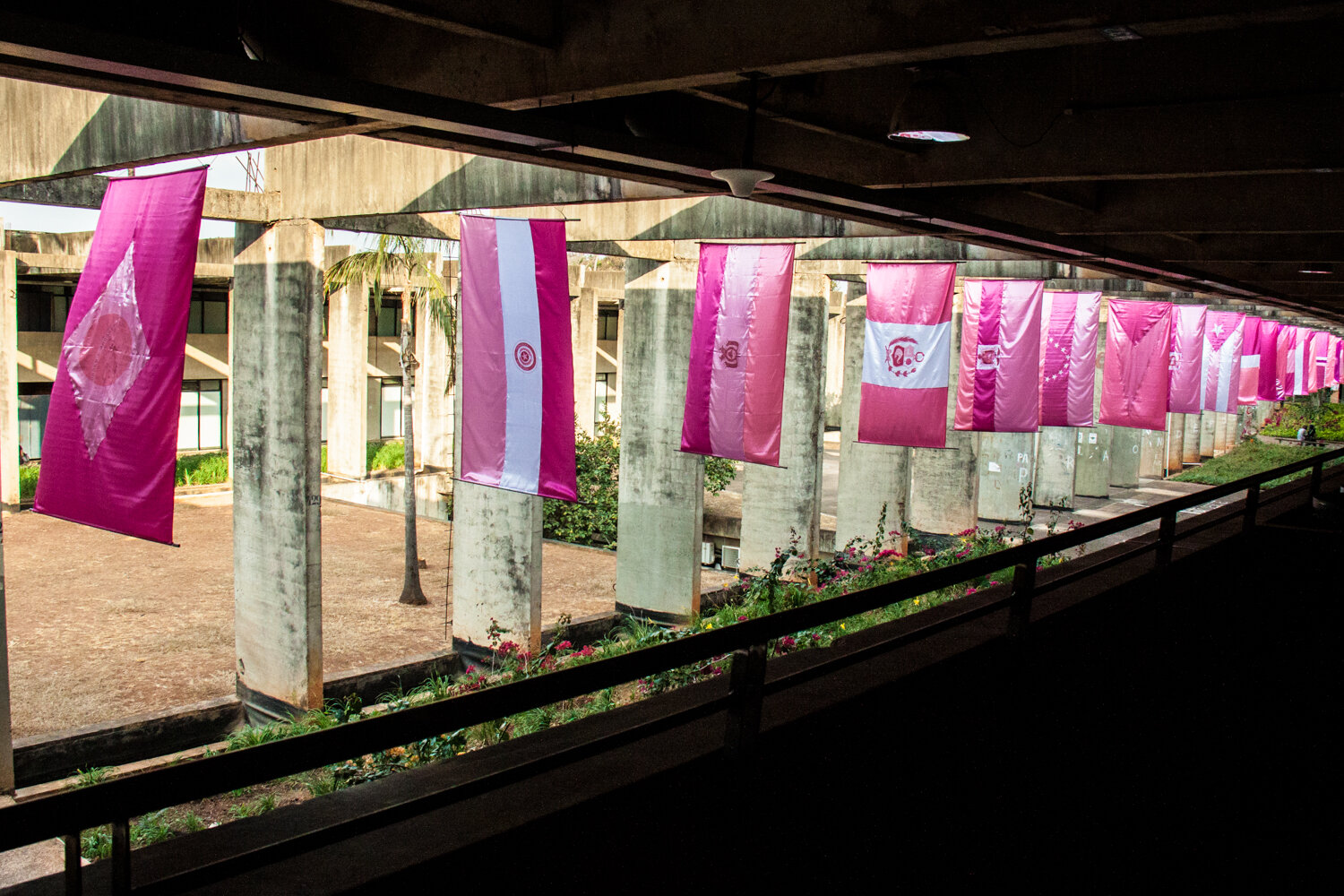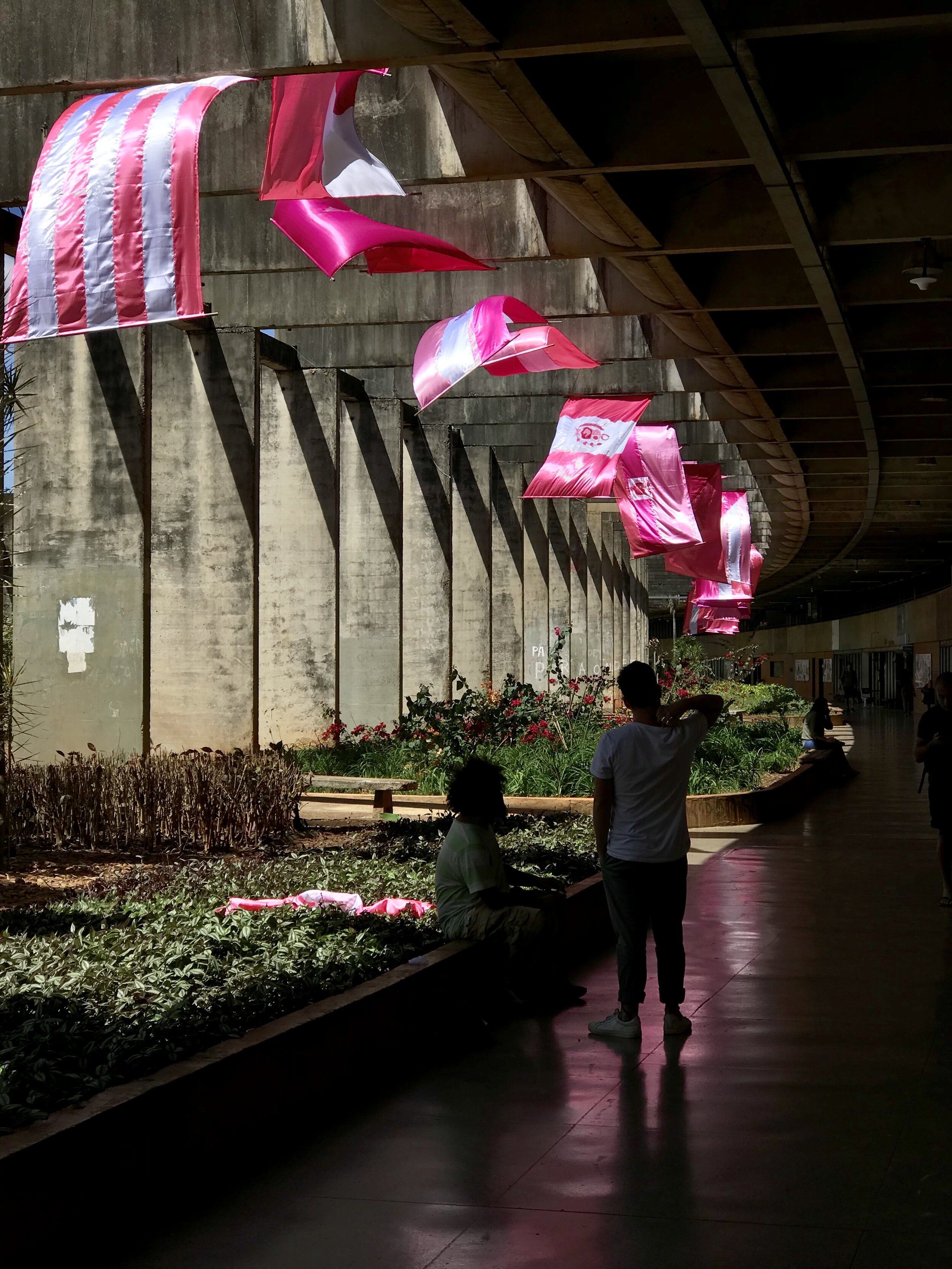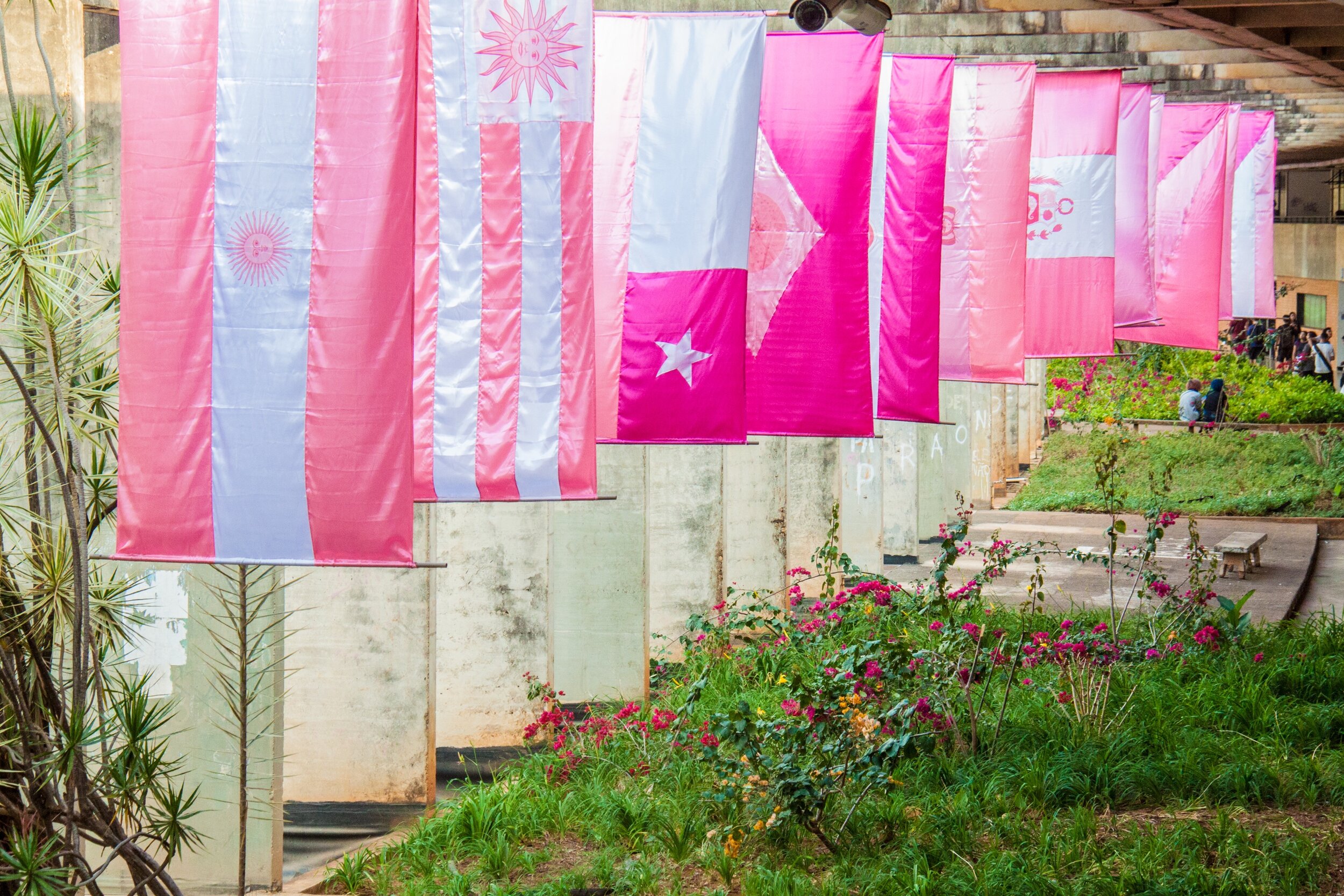*for English scroll down
Hacia el sur de mi cuerpo
If I can't dance, it’s not my revolution
Emma Goldman
No soy un marica disfrazado de poeta
Pedro Lemebel
—
"Amarica: América Invertida" es un proyecto de intervención artística del guatemalteco Esvin Alarcón Lam, diseñado para la arquitectura del Instituto Central de Ciencias - ICC, el cual es a su vez el corredor principal en la Universidad de Brasília - UnB. En 1943, la acción de invertir América fue llevada a cabo por el artista uruguayo Joaquín Torres García en un dibujo emblemático que sedimentó una reorganización abrumadora: "nuestro norte es el sur". En una obra de imaginación política, Lam reinventa 35 banderas, símbolos nacionales de demarcación de fronteras, en diferentes tonos de color rosado.
El triángulo rosa marcó la subordinación impuesta a las poblaciones minorizadas durante el nazismo alemán y fueron resignificados por la resistencia LGBT+ durante la epidemia del VIH. Silencio = muerte, una frase que siguió la forma rosada, aunque inscrita en el momento histórico de la década de 1980 en los Estados Unidos, es una ecuación que exige la posición política con respecto a las tecnologías de desubjetivación. El carácter específico que estas 35 banderas latinoamericanas -junto a las banderas del Caribe y Estados Unidos- adquieren en este lugar una multiplicidad, y llaman al espectador a revelar sus posibles significados.
Si bien el título alude a una América marica o invertida (términos utilizados para designar a los homosexuales) mientras dialoga con la historia del arte en una cita indirecta del dibujo de Joaquín Torres García, el rosa se puede vincular a las luchas de las mujeres y las feministas, así como la resistencia histórica de la población LGBTQIA+ en el siglo XX. Las formas rectangulares de las banderas fueron ordenadas por la posición que ocupan los países en el mapa mundial euro-céntrico: en el extremo norte del ICC, las banderas comienzan con el orden que los territorios nacionales desde América del Sur, comenzando con Argentina, hacia la parte sur del edificio con la bandera de los Estados Unidos.
En un diálogo preciso con las formas sintéticas y los ángulos rectos de la arquitectura moderna del edificio, las banderas ondean en un espacio libre para los estudiantes de esta universidad pública. No es de extrañar que las olas conservadoras que han llegado al poder en Brasil tengan como uno de sus objetivos la desarticulación de las instituciones culturales y académicas del país. El diálogo con las instituciones educativas, así como de subrayar que son campos de batalla de la sociedad civil organizada es una singularidad de este proyecto. Sin embargo, profanar los símbolos fálicos de los nacionalismos; de Estados fallidos y excluyentes, no es el privilegio exclusivo de este proyecto. Esta estrategia artística es parte de un amplio repertorio de obras de arte que utilizan estos objetos para una denuncia social que abandona el lenguaje de estos signos, ampliamente utilizados por los militares como dispositivos de obediencia y control. Al mismo ritmo que la arquitectura, las banderas se configuraron para crear un ritmo tan preciso como insubordinado, constantemente movido por el viento que invade la rígida construcción de concreto.
Entre los 35 países representados aquí, Brasil es el país con la tasa más alta de asesinatos de travestis y personas transgénero. Estamos en la capital del país líder en violencia contra la población trans. Lamentablemente, las transfobias, las homofobias, las misoginia y los femicidios siguen siendo hechos cotidianos frente a todos los logros alcanzados valientemente por los movimientos sociales organizados.
En el repertorio de proyectos ya realizados por Esvin Alarcón Lam, aparecen al menos tres de los elementos que marcan este proyecto: la idea de una América Invertida, la alteración de la palabra 'América' por medio de un poema visual que se apropia y resignifica el término ‘marica', y un cuestionamiento de las identidades nacionales fijas y militarizadas.
Si la historia de resistencia LGBTQIA+ y algunas de las obras del artista nos recuerdan concomitantemente que silencio = muerte, el discurso de odio dado por el presidente de la república a todas estas poblaciones es más perverso que la omisión, o silencio. Las políticas públicas excluyentes con la población transgénero y travesti, con las hermanas seropositivas, y la falta de respeto a las diversas manifestaciones de lo femenino son motivo de revuelta e indignación. Levantar banderas en rosa también es un ejercicio artístico que utiliza el color, pero sobre todo es hacer que existan de otra manera: resignificar es un verbo ampliamente utilizado por cualquier loca, desviado, marica, travesti, mariquita, maricona, es una tradición invertida que abandona la subordinación impuesta por el patriarcado y se enorgullece de su existencia en la conformación de alianzas, una estrategia para la preservación de nuestras vidas.
Ulisses Carrilho
curador
Programación:
performance de vogue
House of Caliandra
16/08/2019, 7:00 PM
Agradecimientos:
Alex Calheiros, João Trevisan, Gabriel Suhet, Mateus Kladi, Ruan Italo.
Helena Lamenza, Yavheni de León, Silvia Trujillo.
Casa da Cultura da America Latina - Universidade de Brasília, House of Caliandra, Instituto Cultura Arte Memória LGBT+ Brasília, Henrique Faria | New York - Herlitzka + Faria | Buenos Aires.
English
Heading South in my body
If I can’t dance, it’s not my revolution
Emma Goldman
I am not a faggot disguised as a poet.
Pedro Lemebel
_
“Amarica: América Invertida” (Inverted America), is a project of artistic intervention of the Guatemalan Esvin Alarcón Lam, designed for the architecture of the Central Institute of Sciences – CIS, which is, at the same time, the main corridor of the University of Brasilia – UnB. In 1943, the act of inverting America was performed by Uruguayan artist Joaquín Torres García, in an emblematic drawing that settled an overwhelming reorganization: “our North is South”.. In a work of political imagination, Lam reinvents 35 flags, national symbols of border demarcation, in different tones of pink.
The pink triangle marked the subordination imposed to minoritised populations during the German Nazism and were resignified by the LGBT+ during the HIV epidemic.
Silence = death, a phrase that followed the pink shape, even though it was written in a historical moment of the 1980 decade in the United States, it is an equation that demands political opposition, with regard to desubjectivization technologies. The specific character of these 35 Latin American flags – together with the flags from the Caribbean and the United States – acquire in this place, a multiplicity, and focuses the attention of the observers on revealing their possible meanings.
Although the title realtes to a faggot or inverted America (terms used to name homosexuals) while it dialogues with art history in an indirect appointment with the drawing of Joaquín Torres García; pink can be linked to the fights of women and feminists, as well as the historic resistance of LGTBQIA+ population in the XX century. The rectangular forms of the flags were ordered by the position these countries occupy in the Euro-centric world map: in the far north of the CIS, flags start in the order of the national territories, starting from South America, with Argentina, towards the southern part of the building, with the United States flag.
In a precise dialogue with the synthetic forms and straight angles of modern architecture of the building, these flags wave in an open space for the students of this public university. It is no wonder that conservative waves, which have come to the power in Brazil aim for disarticulation of cultural and academic institutions of the country. The dialogue with educational institutions, as well as highlighting that these are battle fields of the organized civil society, is a singularity in this project. However, desecrating phallic symbols of nationalisms; from failed and excluding states is not an exclusive privilege of this project. This artistic strategy is part of a broad repertory of art works that use such objects for social denunciation that abandons the language of these signs, widely used by military, as obedience and control devices. At the same pace as architecture, these flags were configured to create a pace, so accurate as insubordinate, constantly moved by the wind that invades the rigid concrete construction.
Among the 35 represented countries here, Brazil is the country with the highest rate of travesty and transgender murders. We are in the capital of the country leader in violence against trans population. Sadly, transphobia, homophobia, misogyny and femicide, are still everyday events, despite all of the gains achieved by the organized social movements.
In the repertoire of projects already performed by Esvin Alarcón Lam, there appear at least three of the elements which mark this project: the idea of an Inverted America, the alteration of the word “America” by means of a visual poem, who appropriates and resignifies the term “faggot” and a questioning of national fixed and militarized identities.
If the resistance history LGBTQIA+ and some of the works of the artist remind us concomitantly that silence = death, is the hate speech given by the president, to all of the populations, is more perverse than omission, or silence. Excluding public policies against transgender and travesty populations, with the zero-positive sisters, and the lack of respect with the diverse manifestations of the feminine, are a motive for revolt and indignation. Rising pink flags is also an artistic exercise, that uses color, but overall, it makes them exist in another way: resignifiying is a verb that is widely used by any loca, ladybug, fairy, travesty, sissy, fag; it is an inverted tradition that abandons the subordination imposed by patriarchy and is proud of its own existence in the formation of alliances; a strategy for protecting our lives.
Ulisses Carrilho
curator
Program:
Vogue performance
House of Caliandra
08/16/2019, 7:00 PM
Acknowledgments :
Alex Calheiros, João Trevisan, Gabriel Suhet, Mateus Kladi, Ruan Italo. Helena Lamenza, Yavheni de León, Silvia Trujillo. | Casa da Cultura da America Latina - Universidade de Brasília, House of Caliandra, Instituto Cultura Arte Memória LGBT+ Brasília, Henrique Faria | New York - Herlitzka + Faria | Buenos Aires.






